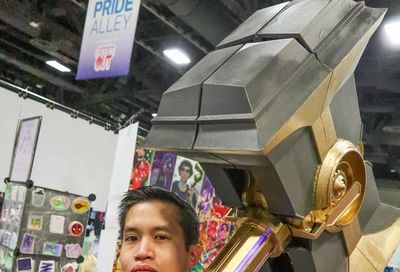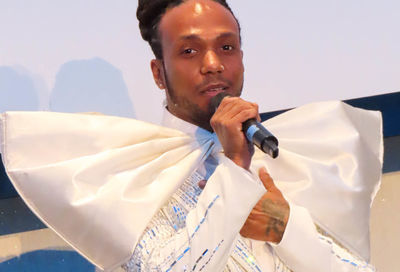Bill T. Jones
The MW Interview
“I intend to live a while. ”
Bill T. Jones takes a sip of coffee.
“And my doctor tells me I’ll live a while. ”
Confident words of self-reassurance from the HIV-positive co-founder of the two-decades-old Bill T. Jones/Arnie Zane Dance company. Jones will turn 50 on February 15, the very day his company presents his latest work at the Kennedy Center, a series of pieces created in collaboration with The Chamber Music Society of Lincoln Center. For more than two decades, Jones has not only pushed the envelope of modern dance, he has ripped it open in defiance. His works have encompassed such potent themes as racism, the ravages of AIDS, and homophobia.
In the world of dance, Jones is a legend. His work is eloquent, virtuosic, provocative, and his 1995 signature piece “Still Here ” is considered a masterpiece by some.
On this particular rainy New York Monday — Martin Luther King’s birthday, to be exact — Jones has chosen Kavehas, a small, trendy jazz-infused coffeehouse in Soho as his preferred place to meet. He is personable, charming, handsome, and speaks with an intellectual authority one would expect of New York’s artistic elite. As he talks of his passion for dance, his companion for the past eight years, Bjorn Amelan, sketches on an artist’s pad.
“I’ve never had a companion who didn’t have some relationship to the core of my life, ” he says, referring to Amelan and, in a roundabout way, Zane, who passed away in 1988. “Bjorn is a sculptor and I’m one of his biggest fans — but my work has been at the center of our life. That’s been part of the romance, part of the wonder. ”
Turning 50 doesn’t seem to throw Jones, although he is pragmatic about the future.
“I’ve lived in a dancer’s body my adult life, ” he says, “in a body that does what I want to do when I ask it to. What happens when it can’t? ”
He shrugs and takes another sip of Kavehas’ strong brew.
“As my doctor says, trust your future self. The funny thing about your future self, though, is you haven’t met them yet. ”
MW: I want to start with your childhood, to the time where the idea of movement became important to you as a form of expression, as a form of art.
BILL T. JONES: I come from migrant workers, as you know — potato pickers in upstate New York. It was a very segregated world and we had to have our own entertainment, because whether it was imaginary or not, black folks didn’t feel welcomed into local bars. There was this jukebox, and we found a way of getting unlimited plays. So we entertained ourselves and each other by dancing.
We were sometimes taken to a local amusement park, which was quite a treat for us. There was a jukebox at the park. My siblings and I put in money and started dancing. An audience — a huge crowd — formed as my sister and I were dancing. Of course the crowd was egging us on — it was a very heady thing. It was my first public performance. I was nine years old and just showing off, but it was about the power of movement and how to hold people’s attention. It was at that point I think that dance as an expressive art was made really tangible and attractive to me.
MW: What factors or influences led you into dance as a career?
JONES: I used to play a game with myself where I would sit for hours and project myself into the future. I remember literally being age nine or ten and going ten years at a time, and I knew I was going to be some person who was going to be in the public eye. Did I know it was going to be about performance? I’m not sure. But you have to realize that in the late Fifties, if a young black child like myself was seeking role models, they would look toward blacks in entertainment. So it was no surprise that I thought that I might go to the stage or television.
There was a drama teacher who was a great guide for me. She was a kind of no-nonsense lady who knocked all of the silliness out of you about performance and was constantly challenging you to not dream but to do. She helped me understand performance as a profession — it was something that you had to study for.
And of course meeting Arnie Zane was an important factor. He was two years older and came from the New York area so he was more sophisticated. He also wouldn’t tolerate hollow dreaming. Whenever I’d say, “I’d like to do this, ” he’d say, “Well, why don’t you do it? ” And then we’d find ways to make it happen.
MW: What did you do in the years prior to forming the company with Arnie?
JONES: I had done solo work, if you can call it solo work. It was very scattershot. We joined a group called the American Dance Asylum in 1974. The group was just like its name — a place where you could find safety for your wild lifestyle ideas. It was a place where you could be as crazy as you like.
MW: New York was a fertile place for artists in the Seventies.
JONES: Yes, but we didn’t think so at first. We were up in Binghamton because we felt we were very much alternative culture type people. We thought New York was a place where you lost your soul and couldn’t make true art because it was so commercial. We didn’t know what we were talking about but that’s what we felt. But at the first show of attention from an impresario, we moved [to Manhattan].
MW: Do you feel that the artistic landscape in New York has changed — or not changed — in twenty years?
JONES: I think highly of the New York environment, but I’m angry as hell at it most of the time because of the trendiness and because of how difficult it is to survive here. But it is an honest place. You have to work hard here. You can pose, but you can pose only so long. Then you’ve got to produce. And you’re only as good as your last performance.
New York allows you to position yourself as an experimental artist. Somehow you’re allowed to experiment and reinvent here. Has that changed? I don’t think the financial aspect has changed much. Judging from my young dancers who come out of college already wanting job security and health insurance, I think it’s a much more sophisticated environment than it was when I came into it. There are just many more people working. The pie is smaller, it’s more competitive.
But there was a time — I’ll go back a generation or so before myself — when you could have a dance company and rehearse for one concert a year. And your dancers could have jobs dancing on Broadway or doing whatever. They’re living for practically nothing, the food was cheaper. Nowadays even the smallest places are extremely expensive and dancers are the lowest paid workers around. So even young emerging artists have to already think with a bit of pragmatism that maybe Arnie and I did not have to think about when we came to New York City in the late Seventies.
MW: I wonder if today’s economic realities dissuade more talented people from going into the arts? Or whether they just say, “Screw it, ” and become lawyers.
JONES: If you have to ask the question, if there is any doubt in your mind, maybe it’s not for you. Believe me, there’s enough people out there who would like to do it. We don’t need people full of doubt and self-interest, flattering themselves to think, “Does the world want me here, does it want me there? ” So if a person’s going to be dissuaded by the fact that they won’t have a middle class life then you know what? They shouldn’t do it. Because this is not about a middle class life. And without getting on a soapbox, I would say that dancing is as much a calling as it is anything else. Don’t think of it as a career. You’re stupid if you do. You’ve got to have something burning in your gut that you want to express.
MW: Isn’t that true of all arts, though?
JONES: I wouldn’t know. I wouldn’t know what it’s like to be a concert pianist. I do think dance still has to prove itself somehow vital to the cultural life of the country. If you interviewed a couple hundred thousand people across the country, you’d be surprised what a small percentage of them even know there’s such thing as modern dance. They might have heard of ballet. They might have heard of Alvin Ailey, even. But have they heard of all the other companies that are out there? Do they know about this tradition that is barely a hundred years old?
MW: One could argue that the this Information Age we live in, will help, that it’s bringing culture into people’s homes. On the other hand, with the rise and accessibility of technology, people are finding less and less reason to leave their homes to watch a performance.
JONES: Which is a shame if you think about it. No matter how good the electronic equipment reproduction, it is not the same thing as that live experience.
People think there is such a glut of things available to them, they don’t bother to ask questions or to really explore. And because people are overwhelmed by the amount of information out there, they tend to narrow down more and more in what they think they like and what they think they don’t like. Performing artists have to understand that we are in the same milieu, the same profession, as Spielberg. What resources do I have? What is my product like? How does it compete with the megadollars and advertising and marketing that goes into those mass entertainments? How do I find my audience? How do I find my voice and stay true to it if I am trying to fill seats? These are the questions that confront performing artists today. It doesn’t stop us. I think it makes us more resourceful spokespersons for what we believe and love.
I am devoted to dance — that’s what my “commercial ” is. If I have to advertise myself, how do I package it? Is it a seductive package? Is it beautiful? Is it sophisticated enough to know how to use the language of the times, to get those butts in the seats? How do we get someone to turn off that internet and come out to the theater and see what I do? This is what’s challenging, sometimes dauntingly so.
MW: It seems to me that you have always taken great pride in your sense of self.
JONES: I came about in a time when black determination and black self-esteem was paramount, it was the obligation of any young black person to be upwardly mobile — we were expected to be better than our parents. So I came into the art world with a full sense of my need to fight to be. I did not want to be Ralph Ellison’s “Invisible Man, ” and I was determined that I would be understood as myself.
Now, I’d also had the experience of the alternative culture in the 1960s that said we are not our bodies, we are not the values that are imposed upon us by this repressive society with its hypocrisy and its troubled history, so be free. Free to love who one wants to love. Free to live where one wants to live. Free to create. That was my religion, if you will. I think that by speaking honestly about who I was as a gay man, and not hiding, people assumed I was waving it like a banner. But I was only trying to claim for myself the same rights as anyone else. Nobody ever asked Nelson Rockefeller to justify being a white male heterosexual, did they? He just was. So Arnie and I just were. We held hands in public, we were trying to really live the dream that we are “Free at last, free at last, thank God almighty we are free at last. ” The culture was not there of course. So any statement of affirmation on your part became a political statement and you got saddled with being militant.
When I began, I did not want to be classified as anyone’s black artist, because a black artist was a commodity, a thing to be manipulated and placed in a category. I wanted freedom to invent and reinvent myself. You have to tell the world, “I define myself. I will not be defined. ” The same with my gay status — just like being black. It was a truth about me.
MW: Still, you were courageous at a time when others hid their identities as gay men, when others hid their HIV status for fear of being ostracized.
JONES: I’m not afraid to stand up, I’m not afraid to be looked at. It’s part of my narcissism, but it’s also part of my mission, standing up and saying “I’m black, I’m gay, I’m HIV, I’m alive, and I’m alright. ” I’m saying, “I shout out, now you shout back. ” Making my art is a way of saying to people — gay people, HIV positive people — life is worth it.
MW: You have moved away from generating controversy with your work. Any reason?
JONES: Once you’ve been made a symbol that people can bicker about, you’re scarred in a way that never goes away. If you’re like most of us, you’re tough, you keep going. But you have a kind of “A ” that adulterers used to have to wear in New England — a Scarlet Letter. Maybe it’s not visible to the public, but it’s there, and you will live with it for the rest of your life.
I think in terms of career, fashions come and go, people have longer and shorter memories. Nothing that is here today will be here forever. So the controversy surrounding my work in the mid-nineties made me aware of how art could be hard news — what it takes, what it costs. I paid with great heartache and a lot of real pain. I had to ask myself, do I want to pay that price again and again?
So I went back to look at what there was about dancing that I loved. I decided I’m an artist whose major expression is through movement. And my work has really continued to evolve. The Lincoln Center Chamber Music Society work is a result of years of struggle about what art looks like to me. There’s no talking in it and no specific references to my personality or my race in it. I have been trying now over the years to say, “Look at my company, look at the racial diversity, look at the way we handle each other on stage. ” I don’t want you to forget what color we are when you look at us on stage, but I want you to see this disparate community of people succeeding and transcending their differences for the sake of — what? Bill T. Jones’ ego? I don’t think so. I’m not on the stage. This work can now go on without me.
Support Metro Weekly’s Journalism
These are challenging times for news organizations. And yet it’s crucial we stay active and provide vital resources and information to both our local readers and the world. So won’t you please take a moment and consider supporting Metro Weekly with a membership? For as little as $5 a month, you can help ensure Metro Weekly magazine and MetroWeekly.com remain free, viable resources as we provide the best, most diverse, culturally-resonant LGBTQ coverage in both the D.C. region and around the world. Memberships come with exclusive perks and discounts, your own personal digital delivery of each week’s magazine (and an archive), access to our Member's Lounge when it launches this fall, and exclusive members-only items like Metro Weekly Membership Mugs and Tote Bags! Check out all our membership levels here and please join us today!

























